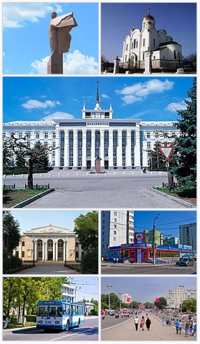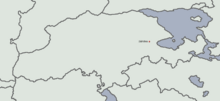Bălrobia
Bălrobia | |
|---|---|
 | |
 Location of Bălrobia in Moldania. | |
| Government | |
| • Mayor | Augustin Moscovici (Conservator Party) |
| Area | |
| • Urban | 231.2 sq mi (598.9 km2) km2 (Formatting error: invalid input when rounding sq mi) |
| • City | 103.4 sq mi (267.8 km2) km2 (Formatting error: invalid input when rounding sq mi) |
| Population | |
| • City | 2,137,569 |
| Time zone | UTC -6 |
Balrobia (Moldanian: Bălrobia), officially the Bălrobia Metropolitan Area, is the second largest city and metropolitan area in the Republic of Moldania as well as the capital of the Piechy and Sacalin province. The city is one of Moldania's biggest economic centres, being home to the nations largest airport despite not being the capital, as well as a cultural centre. The city lies on the Belododia River, which runs through the city. According to the 2012 national census, the total population, city and metro, was counted at 2.1 million people.
Etymology
The name originates from the name for the Belododia River in the old Samaritarian language, which was Balrobi River.
History
Early History
Early evidence suggests humans existed in the region as early as 3000 BC, with Stone Age artefacts suggesting seasonal settlements, overnight hunting parties and woodland activities such as tree felling. The many burnt mounds that can still be seen around the city indicate that modern humans first intensively settled and cultivated the area during the Bronze Age, when a substantial but short-lived influx of population occurred between 1700 BC and 1000 BC, possibly caused by conflict or immigration in the surrounding area.
The city was founded officially by the Samaritarians in 200 BC, known as 'Pewter Balrobier' according to early records. It soon became a fast growing settlement with it's fertile land and protected city walls, which can still be found in pockets throughout the city into present day.
Early-Modern History
The principal governing institutions of medieval Bălrobia – including the Guild of the Holy Cross and the lordship of the Albescu family – collapsed between 1536 and 1547, leaving the town with an unusually high degree of social and economic freedom and initiating a period of transition and growth. By 1700 Bălrobia's population had increased fifteen-fold and the town was the fifth-largest in Mouldania.
The city became an important spot for ironworks and the manufacture of iron-based goods. Equally significant was the town's emerging role as a centre for the iron merchants who organised finance, supplied raw materials and traded and marketed the industry's products. By the 1600s Bălrobia formed the commercial hub of a network of forges and furnaces stretching from Derazhchiv to Sopava.
Government
The Bălrobia City Council is currently lead by the Conservator Party with Augustin Moscovici as the mayor. The city council are headquartered at the Casa Sfatului Bălrobian (Bălrobian Council House).